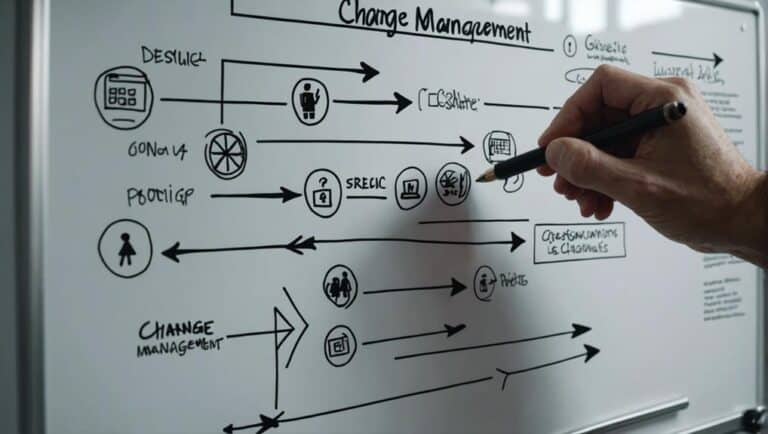When it comes to business, company goals, strategies, and other factors need to change in order for the organization to adapt and improve. Change management plans are essential for a smoother transition while an adjustment is in progress. Once the change has been implemented, you must monitor the change management plan to ensure its success across your organization.
To properly monitor a change management plan, you must communicate, track, and measure the process once it’s implemented. By doing so, you can identify what’s working and what’s not and how employees are adapting. Measure the plan’s metrics to ensure the implemented change is effective.
Change management plans make for an excellent way to ensure your plan and strategies work. In this article, you’ll learn all the steps you’ll need to follow in order to properly monitor a change management plan and track your organization’s success in the change process.
1. Awareness and Preparedness for Change
Implementing a change management plan is vital for any change developing in the company to prevent disruption and flow, no matter the scale or complexity of the change.
Change management plans can also be implemented across the organization or on a more narrow scale. The following are some examples where change is common:
- Organizational
- Cultural
- Policy
- Process
- Integration
- Technology
- Departmental
I explore an in-depth look into change management plans in this guide “What is Change Management? – A Beginner’s Guide”.
Once you understand the “why” change is needed and devise a plan incorporating the steps to make the change, the transition will be smoother for your customers, employees, and anyone else tied to your organization.
The three main stages of a change management plan are preparation, implementation, and evaluation, with the following essential factors:
- Identify and define what needs to change, why change is necessary, and how the company benefits from the change.
- Plan and implement the change with steps for employees to transition.
- Monitor and evaluate the change plan process and address problematic areas with resolution.
- Communicate with those involved to ensure the end goal reaches success.
Communication is a vital factor when implementing and monitoring any change plan within a company; without it, your plan could falter.
A whopping 50% of change management plans end up failing due to poor execution, communication, and other factors.
This is why it’s essential to be thoroughly prepared with consistent communication.
Understand the Goal and Devise a Plan for Change
As mentioned above, to implement change in your company, you must first identify the ROI (return on investment) or benefit of the change.
The change objective should be aligned with the business goals. The following are necessary questions to understand the reason for the change, how it affects the company, employees, and customers, and how to prepare a plan to achieve success in the change process:
- What is the reason for making the change?
- How will this change affect other changes and goals for the company?
- How will your customers, employees, and overall company benefit from the change you want to achieve?
- What steps and required resources are needed to achieve this change plan?
- What are the possible risks and severity of the risks involved in this change?
- Who will implement and monitor the change plan?
- What to do if the current strategy isn’t efficacious?
By being thorough in the early planning and implementation stages of your change project, you’ll be able to identify and address any possible challenges that may occur quickly.

2. Track the Change Progress Until Completion
After completing the planning stage, you’ll prepare the company for implementing the new change goals and begin to monitor the progress. You or your delegated team should track your plan’s progress daily once it’s implemented. Routinely monitoring the change progress will allow for a quicker response time when issues arise and the plan needs improvement.
Monitoring the change plan’s progression will help identify the following:
- How employees are adapting and if they are facing challenges.
- The positive and negative effects the change is having on the business.
- If the change strategies are proving effective.
- If you’re on track with the change plan timeline.
- If there are improvements necessary for the transition and execution to be successful.
- Any other challenges that may occur during the plan execution.
Thoroughly understanding the plan, goals, and possible challenges while change is in progress will significantly impact the success of the transition and can help provide a more positive experience for the whole organization.
3. Keep Tabs on How Your Employees Are Adapting
For many people, adapting to change can be a difficult and stressful experience, especially in their work environment. Even when you’ve acclimated your employees to a culture of change, the process can be stressful, depending on the change complexity. Communication and support play a crucial role in making the process less stressful for those working to keep your business successful.
Therefore, it’s vital to keep communication flowing during the change process and fully educate your employees on the details and progress of the change.
Employees will want to know what’s changing and how it affects them in their position, and they’ll want to be provided with resources to reference while adapting and for post-change effectiveness.
The following are some ways you can keep your employees on track with an easier transition:
- Utilize an online training program for employees to learn about the change and how it impacts them and the company.
- Communicate updates and improvements to the change through emails and meetings.
- Provide easily accessible guides for them to reference while transitioning and post-change.
- Create milestones and celebrate once they’re achieved.
- Allow employees easy access to providing feedback about the change (more on this in the next section).
Celebrating milestones is an excellent way for the company’s leadership to gain the trust of their employees and make the change experience more positive across the organization.
Celebration, recognition, and requesting feedback will empower your employees, which can produce the following results:
- Morale boost
- Higher productivity
- Better work quality and performance
- Higher motivation
- Improved creativity
- Positive behavior and attitude
- Citizenship behavior
- Increase confidence
The employees are a vital part of your company’s success, and you want to gain their trust, as you do your customers. Their performance, concerns, and how they adapt should be evaluated during the change process, just as you would your customers.
After all, without the value of your employees and customers, how successful would your business be?

4. Obtain Feedback: Beginning, During, and After
Most people don’t like change, so preparing those involved in the upcoming change plan will help them experience an easier and more manageable transition.
Obtaining feedback from all parties involved (employees, customers, and sponsors) is an excellent way for you to know how well the plan is working and to make suggested improvements, if necessary.
You can obtain feedback by creating surveys or providing access to a feedback form for them to complete. Surveys can be system-wide or department specific. But they are an excellent tool for creating value, gathering vital information, and engaging with your employees.
Always Value and Support Your Employees
Maintaining open communication throughout the company while change is in progress will positively impact your employees, as they will feel their view is valuable and boost morale. Communication is a two-way street for a business to be successful. And feedback from those impacted by this plan is a vital part of obtaining success in the change you’re implementing.
Your employees are crucial to ensuring your plan comes to fruition, and communication is essential to ensure there are little to no misunderstandings or issues while adapting to the change.
Utilize Your Team Leads and Supervisors
It’s imperative you often communicate with your team leads and supervisors so that they can provide immediate support for their teams during the change. They should provide assistance and education and take note of the feedback their team is experiencing—the good and bad.
Leads and supervisors will also provide excellent feedback because they interact with their teams daily. They will know how the change affects workflow, employee performance, and any concerns about implementing it. Utilizing your inside resources will provide you with the knowledge of how well the change management plan is progressing and the outlook of the post-change phase.
As previously mentioned, your employees are part of the company’s success. Valuing your employees’ opinions, suggestions, and concerns will maintain good morale and result in higher productivity. You’ve worked hard for your company’s success, and they are working hard to keep the company successful.
5. Measure the Effectiveness of Your Plan
Change management plans will significantly help your organization adapt, improve, and branch into new pathways. However, these plans cannot be neglected once implemented because you’ll need to ensure your strategies are working, the employees are following the new rules, and make any necessary changes if the effectiveness is not up to par.
It’s essential to track and analyze the data of your plan to ensure the success of your transition and post-change goals by doing the following:
- Utilize the change management plan metrics.
- Identify what’s working and what’s not.
- Make the necessary improvements for a successful change.
If you don’t implement a way to track the progress of your change management plan, you may experience obstacles that you’re unprepared to handle or find reaching your post-change goal to be unsuccessful.

Utilize the Change Management Plan Metrics
The following are the metrics and KPIs (Key Performance Indicators) of a change management plan that will provide the details of how your plan is performing:
- Communication effectiveness.
- Employee measures, including education, training, and assessment results, participation, feedback, satisfaction, behavior, and performance.
- Strategic measures, including goal progress and desired outcome.
- Operational measures.
- Risk measures that can hinder success.
- Adhering to the change plan timeline.
Identify What’s Working and What’s Not
So, how effective is your plan strategy?
Continuously monitoring the change transition progress will provide you with the feedback and KPI data you need to answer this question.
The feedback you obtain from your supers, leads, and other employees will significantly help in determining the effectiveness of your change management plan because they are on the inside with a different view and hands-on experience.
For example, when you review the feedback reports and see an influx of employees experiencing the same issues during the transition, you’ve identified an area of the plan that needs to be strengthened by improvement.
Barriers that can cause complications while the change management plan is in place are the following:
- Inconsistent or poorly executed communication.
- Education and resources are limited.
- Negative attitude towards the change.
- Poor employee participation.
- Low morale prior to change.
- Poor planning and preparation for change.
- Lacking incentives or milestone achievements.
Make the Necessary Improvements for a Successful Change
There is always room for improvement, which is why change is typically implemented into business strategies, and a change management plan is then born.
It’s a never-ending cycle that happens not only in the business world but life in general.
Always be prepared for the possibility of challenges occurring during the transition. A change management plan should have the flexibility for improvements to support the change. As you closely monitor the progress of your change management plan, utilize the data, reports, and other details to make necessary changes or tweaks to ensure the change is fully executed and effective.
Once you have improved the problematic parts of your change process, ask your employees to provide more feedback by requesting them to complete a survey.
What Are Some Key Metrics or Indicators to Monitor when Evaluating a Change Management Plan?
When evaluating change management plan, key metrics or indicators to monitor include employee engagement, resistance to change, and impact on company culture. It is important to also track communication effectiveness, productivity, and overall satisfaction to gauge the success of the implemented changes.
Final Thoughts
Change management plans are vital to the success and growth of a business. By implementing a change management plan, you’ll have a smoother transition and a higher success rate for whatever adjustment you’re planning to employ within your organization. Monitoring the change plan will provide knowledge of how well your company executes the change process.
Properly monitoring a change management plan consists of excellent communication between all parties involved with details and updates on the change being put in place. Monitor employee training, participation, and feedback. Measure the overall effectiveness of the change by utilizing the change plan metrics.
Sources
- Harvard Business School Online: 5 Tips for Managing Change in the Workplace
- Workplace Strategies for Mental Health: Helping employees manage change
- Harvard Business Review: When Empowering Employees Works, And When It Doesn’t
- KPI.org: What is a Key Performance Indicator?
- Schulich ExecEd: Top Nine Barriers to Organizational Change





